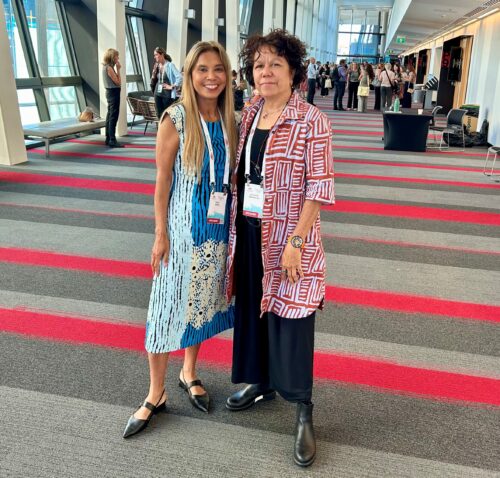Cultural Heritage Laws and Indigenous Cultural Heritage
Places and objects that are significant to Aboriginal and Torres Strait Islander people may be protected under cultural heritage laws.
What are cultural heritage laws?
Heritage laws aim to safeguard cultural heritage. They recognise and protect significant sites, objects, and artefacts, so that they may be protected for future generations.
Cultural heritage can be tangible (physical – such as land or objects) or it can be intangible (such as stories and knowledge). Currently cultural heritage laws in Australia generally protect only tangible cultural heritage.
Cultural heritage laws are different across Australia. Some of the laws are Federal, and some are State or Territory laws. Sometimes the protection for important places and objects is automatic. Other times, the protection requires registration or a declaration.
There are specific heritage laws that protect the cultural heritage of Aboriginal and Torres Strait Islander peoples. This information sheet focuses on those laws. When this information sheet refers to cultural heritage, it is referring to the cultural heritage of Aboriginal and Torres Strait Islander peoples.
How do Federal laws protect cultural heritage?
Cultural heritage is protected under several Federal laws. This includes:
- Protection of significant Aboriginal areas and significant Aboriginal objects from injury or desecration. This protection is by way of making a declaration under the Aboriginal and Torres Strait Islander Heritage Protection Act.
- Protection of places of national importance through the National Heritage List (including World Heritage Sites) under the Environment Protection and Biodiversity Act. A place can be of national importance because of its Indigenous heritage. Some examples of Australia’s World Heritage Sites protected under this Act include Kakadu National Park and Uluru-Kata Tjuta National Park.
- Protection of underwater cultural heritage through the Underwater Cultural Heritage Act.
- Protection of cultural objects by regulating their export under the Protection of Movable and Cultural Heritage Act. These laws protect objects that are of importance to Australia’s cultural heritage for ethnological, archaeological, historical, literary, artistic, scientific or technological reasons.
Exporting artwork and Aboriginal and Torres Strait Islander cultural heritage
The Protection of Movable and Cultural Heritage Act, is an important legislation for artists and art organisations. It means that certain art and objects cannot be exported, and that other art and objects cannot be exported without a permit.
Items that cannot be exported include certain objects of Aboriginal and Torres Strait Islander heritage such as bark and log coffins, human remains, rock art, dendroglyphs (carved burial and initiation trees), and secret and sacred ritual objects. Other items may be exported from Australia only with permission. These are called “class B objects. These include:
- Objects of cultural significance to Aboriginal or Torres Strait Islander people or made by Aboriginal or Torres Strait Islander people that are at least 30 years old and are not adequately represented in collections in Australia, as long as the objects were not specifically created for sale.
- Fine or decorative art that is ‘Australia-related’ for example because they were made in Australia or by an Australian. Fine or decorative art is protected if it is at least 30 years old and has a market value over a certain amount. The amount is set out in a table, and is specific to the type of art. For example, the amount for:
- Aboriginal desert paintings (including pre-1974 Aboriginal Papunya paintings), other than paintings that are secret/sacred objects, is $100,000
- Aboriginal Kimberley paintings on canvas is $100,000
- Aboriginal or Torres Strait Islander ochre paintings that are on bark, composition board, wood, cardboard, stone or other similar supports is $20,000
- Watercolours, pastels, drawings and sketches is $40,000
- Sculptures is $30,000
For more information, see the Office for the Arts’ website.
How do State and Territory laws protect of cultural heritage
The States and Territories also protect cultural heritage through various laws. Much like the Federal level, there are multiple laws that protect cultural heritage.
All States and Territories have specific protections for Aboriginal objects, places and ancestorial remains. In very general terms, common features include:
- Automatic protection for some cultural heritage, and a requirement for a declaration or registration of other forms of cultural heritage or protection. For example, in NSW, Aboriginal places are protected if they are the subject of a declaration, but Aboriginal objects receive automatic protection. In Victoria, the protection of objects and places is automatic.
- All States and Territories have a permit process for engaging in certain activities in relation to cultural heritage. These laws are designed to protect the cultural heritage.
- It is against the law in every State and Territory to harm or damage cultural heritage without permission. Exceptions (or defences) to this generally include compliance with permits or other forms of authorisation. Defences can also include not having knowledge of the likely harm, or the exercise of due diligence in relation to whether or not an Aboriginal object or place would be harmed.
- A common feature is the establishment of heritage councils or similar bodies to oversee the protection of cultural heritage. Most States and Territories have a cultural heritage database and registers that work to assist organisations to for fill their due diligence requirements.
Despite some similarities in protections, the laws are different in each State and Territory. There is also no nationally coordinated approach. This lack of national uniformity and coordination has been criticised.
Other types of laws, such as native title and planning laws, may also give some protection to cultural heritage.
Are there laws that protect intangible cultural heritage?
Victoria is the only jurisdiction which specifically protects intangible heritage as well as tangible. Intangible cultural heritage can be protected in Victoria under the Aboriginal Heritage Act only if it is registered. Intangible heritage is defined to mean any knowledge of or expression of Aboriginal tradition, and includes oral traditions, performing arts, stories, rituals, festivals, social practices, craft, visual arts, and environmental and ecological knowledge. It does not include anything that is widely known to the public and does not include places, objects and ancestral remains. It also includes any intellectual creation or innovation based on or derived from the knowledge or expressions of Aboriginal tradition.
Despite the introduction of laws protecting intangible heritage, the laws have been infrequently used and have been criticised. As at October 2020, there was only one registration of intangible heritage on the Victorian Aboriginal Heritage Register.
Intangible cultural heritage can also receive some protection under other laws, such as intellectual property laws. These laws (such as copyright) can protect intangible property. However, they are not designed specifically for the protection of cultural heritage. For more information, see the Arts Law information sheet on Indigenous Cultural and Intellectual Property.
Are cultural heritage laws being changed?
Recent reviews and reports, such as ‘A Way Forward’ by the Joint Standing Committee on Northern Australia inquiry following the destruction of Juukan Gorge, have referred to several deficiencies in Australia’s cultural heritage protection:
- A lack of legislative uniformity.
- Developments are prioritised over the protection of Aboriginal cultural heritage.
- Lack of enforceability and compliance.
- Disregard for intangible heritage which is counterintuitive to international standards.
Following that report, the Australian government agreed to introduce new laws for cultural heritage at a national level. The Australian government is currently working on reforming cultural heritage laws and protection. More information about that reform process can be found on the Department of Climate Change, Energy, Environment and Water website. This reform is occurring in tandem with the Government’s efforts to improve the protection of intangible cultural heritage.
In addition to the Federal reform processes, each state and territory have initiated plans to consider state and territory laws protecting cultural heritage. Key areas for consideration for reform include how approvals are sought and granted and intangible heritage. The reform process is ongoing and is taking time.
Are there international laws about cultural heritage?
Outside of Australia’s laws there are several international treaties and documents that aim to protect cultural heritage. International treaties and documents do not apply directly into Australian law. They need to be introduced into specific Australian laws first.
United Nations Declaration on the Rights of Indigenous Peoples 2007
The United Nations Declaration on the Rights of Indigenous Peoples (UNDRIP) is a declaration which establishes an international framework for the rights and protection of Indigenous people including their cultural heritage. It is based on recognising the right that Indigenous peoples have the right to self-determination. Australia endorsed UNDRIP in 2009, but it is not legally binding. The declaration expressly includes the protection of cultural heritage, including:
- The right to maintain, protect and develop manifestations of culture, such as sites, artefacts, designs, ceremonies, technologies, arts and literature.
- The right to use and control ceremonial objects.
- The right to revitalise, use, develop and transmit to future generations histories, languages, oral traditions, philosophies, writing systems and literature.
- The right to maintain, control, protect and develop cultural heritage, traditional knowledge and traditional cultural expressions.
Convention for the Safeguarding of Intangible Cultural Heritage
The United Nations Educational, Scientific and Cultural Organisation (UNESCO) Convention for the Safeguarding of Intangible Cultural Heritage aims to protect intangible cultural heritage.
In 2022, the Australian Government agreed in principle with a recommendation that Australia agree to this Convention. It is considering the Convention alongside current reform processes. If it does formally agree to be bound by the Convention (this is called ‘ratifying’), Australia will need to introduce laws in Australia that give effect to the Convention.
Nagoya Protocol
The Nagoya Protocol on Access to Genetic Resources and the Fair and Equitable Sharing of Benefits Arising from their Utilisation is supplemental protocol to the UNESCO Convention on Biological Diversity. It aims to establish make sure that the benefits of biotechnology research that use traditional knowledge are shared with Indigenous persons. Australia has not signed the Nagoya Protocol, but the Government states that Australia’s existing measures are consistent with the protocol.
UNESCO World Heritage Convention
The UNESCO World Heritage Convention is a Convention which establishes the requirements for countries to register potential world heritage sites. The Convention includes the World Heritage List. Australia ratified the convention in 1974 and has several World Heritage sites listed, including the Great Barrier Reef, Kakadu National Park, and Gondwana Rainforests of Australia.
Disclaimer
The information in this information sheet is general. It does not constitute, and should be not relied on as, legal advice. The Arts Law Centre of Australia (Arts Law) recommends seeking advice from a qualified lawyer on the legal issues affecting you before acting on any legal matter.
While Arts Law tries to ensure that the content of this information sheet is accurate, adequate or complete, it does not represent or warrant its accuracy, adequacy or completeness. Arts Law is not responsible for any loss suffered as a result of or in relation to the use of this information sheet. To the extent permitted by law, Arts Law excludes any liability, including any liability for negligence, for any loss, including indirect or consequential damages arising from or in relation to the use of this information sheet.
© Arts Law Centre of Australia
You may photocopy this information sheet for a non-profit purpose, provided you copy all of it, and you do not alter it in any way. Check you have the most recent version by contacting us on (02) 9356 2566 or tollfree outside Sydney on 1800 221 457.
The Arts Law Centre of Australia has been assisted by the Commonwealth Government through the Australia Council, its arts funding and advisory body.




